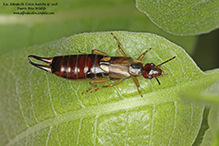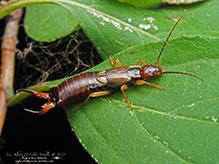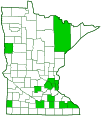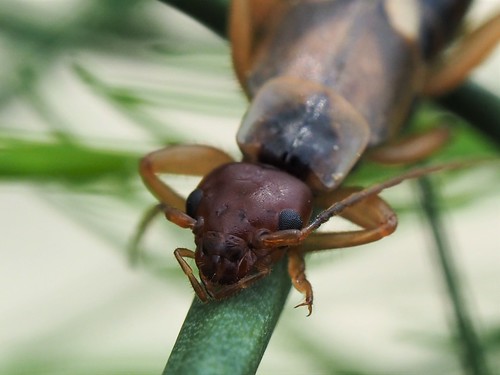European earwig
(Forficula auricularia)
Conservation • Description • Habitat • Ecology • Distribution • Taxonomy
|
|
||||||||||||||
Description |
European earwig is native to Europe, western Asia, and North Africa. It was introduced into North America in 1907 or earlier and spread quickly, hitchhiking in vehicles and in shipments from other countries. It is now found across the continent and is the most abundant earwig in North America. Adults are ½″ to ⅝″ long. The head, thorax, and abdomen are dark brown or reddish-brown. The plate covering the upper side of the thorax (pronotum) is shield-shaped and mostly dark brown with pale, translucent margins. The forewings (elytra) are dark or light brown to somewhat translucent. The hindwings are folded beneath the elytra with the tips exposed. The abdomen is usually dark brown to reddish-brown on each segment, giving it a faintly striped appearance. Sometimes the abdomen appears entirely dark brown. At the end of the abdomen there is a pair of long, forcep-like appendages (cerci). On the female, the cerci are about ⅛″ long and are mostly straight, in-curved just at the tip. On the male the cerci are 3 ⁄16″ to ⅜″ long and are strongly curved. The antennae are thread-like and have 14 segments. The legs are yellow to brown. The last part of the leg (tarsus) has three segments. The second tarsal segment has a lobe at the end that is expanded both to the side and forward under the third tarsal segment. |
Size |
Total length: ½″ to ⅝″ |
Similar Species |
Habitat |
Forests, agricultural fields, suburbs |
Ecology |
Season |
One generation per year |
Behavior |
European earwigs are active at night. During the day they remain concealed under leaf debris or in other moist, close places. They live in large congregations except in mating season. |
Life Cycle |
Mating takes place in September. In the fall, the mated female digs a burrow 3 ⁄16″ to 5 ⁄16″ (5 to 8 mm) underground. Adults overwinter either as brooding pairs or in congregations. In late winter or early spring, the female drives the male from her burrow and lays a clutch of 30 to 55 eggs. The males often die when kicked out of the burrow in late winter. The eggs hatch in about 70 days. The offspring are independent after two months and reach sexual maturity at three months. |
Nymph Food |
|
Adult Food |
Adults are omnivorous, feeding on live and dead small insects and on living and dead plant matter. |
Distribution |
||
|
Sources Note: The map includes Forficula auricularia species complex on iNaturalist, but Forficula auricularia is the only species in that complex that occurs in Minnesota. |
|
| 5/2/2024 | ||
Nativity |
||
Native to Europe and western Asia, and North Africa. Introduced and now widespread. |
||
Occurrence |
||
Common and widespread |
||
Taxonomy |
|
Order |
Dermaptera (earwigs) |
Suborder |
Neodermaptera (extant earwigs) |
Infraorder |
Epidermaptera |
Parvorder |
Eteodermaptera |
Superfamily |
Forficuloidea |
Family |
Forficulidae (common earwigs) |
Subfamily |
Forficulinae |
| Genus | Forficula |
no rank |
Forficula auricularia species complex |
Forficula auricularia species complex is an artificial grouping of at least four species that cannot be distinguished morphologically. Two of those species have been introduced into North America, and they are broadly separated geographically. Forficula dentata occurs only in the west, and Forficula auricularia occurs in the east and upper Midwest, including in Minnesota. |
|
Subordinate Taxa |
|
|
|
Synonyms |
|
|
|
Common Names |
|
common earwig European earwig |
|
A common myth is that the name earwig refers to the insects crawling into the ears of sleeping human beings. In fact, it refers to the shape on the unfolded, semicircular hindwing, which vaguely resembles a human ear. |
|
Glossary
Cercus
One of a pair of small sensory appendages at the end of the abdomen of many insects and other arthropods. In Odonata, one of the upper claspers. Plural: cerci.
Elytra
The hardened or leathery forewings of beetles used to protect the fragile hindwings, which are used for flying. Singular: elytron.
Pronotum
The exoskeletal plate on the upper side of the first segment of the thorax of an insect.
Tarsus
On insects, the last two to five subdivisions of the leg, attached to the tibia; the foot. On spiders, the last segment of the leg. Plural: tarsi.
Visitor Photos |
||
Share your photo of this insect. |
||
This button not working for you? |
||
Alfredo Colon |
||
 |
 |
|
 |
||
MinnesotaSeasons.com Photos |
||
|
||
|
||

Visitor Videos |
||
Share your video of this insect. |
||
This button not working for you? |
||
|
Other Videos |
||
Common earwig (Forficula auricularia) - 2014-06-15 |
About
Published on Jun 17, 2014 Forficula auricularia, the common earwig or European earwig, is an omnivorous insect in the family Forficulidae. ---------- De gewone oorworm (Forficula auricularia) is een insect dat behoort tot de orde oorwormen (Dermaptera). Geo location: 52.05006 4.22839 |
Forficula auricularia |
About
Published on Jan 15, 2018 © I.Diana-Alexandra |
Gemeiner Ohrwurm (Forficula auricularia) - Macro movies |
About
ublished on Sep 26, 2012 Der gemeine Ohrwurm (Forficula auricularia) http://www.Tierportraet.ch |

Visitor Sightings |
||
Report a sighting of this insect. |
||
This button not working for you? |
||
| Alfredo Colon 6/11/2024 |
Location: Albany, NY |
 |
| Alfredo Colon 6/10/2024 |
Location: Albany, NY |
 |
| Alfredo Colon 8/29/2022 |
Location: Albany, NY |
 |
| Alfredo Colon 7/12/2018 |
Location: Woodbury, MN |
 |
MinnesotaSeasons.com Sightings |
||
|

Created: 1/8/2019 Last Updated: © MinnesotaSeasons.com. All rights reserved. |



